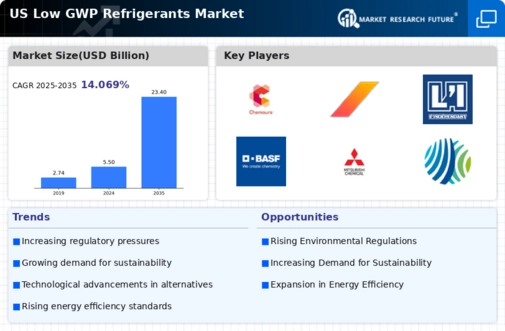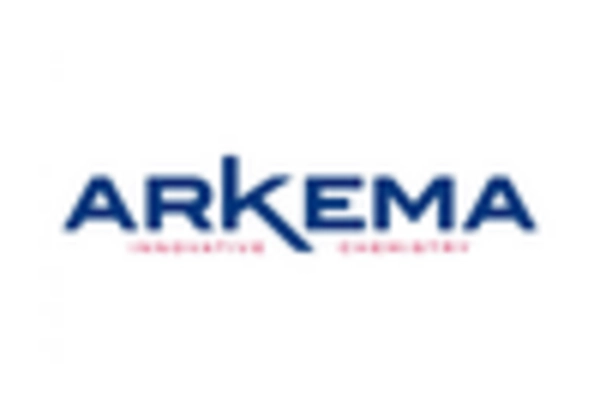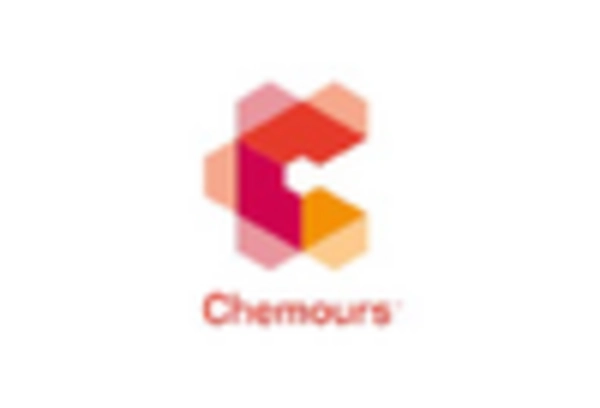Regulatory Compliance Pressure
The low gwp-refrigerants market is experiencing heightened pressure from regulatory compliance, particularly in the United States. Federal and state regulations are increasingly stringent, aiming to phase out high GWP refrigerants. The Environmental Protection Agency (EPA) has implemented rules that mandate the transition to low GWP alternatives, which has led to a surge in demand for compliant refrigerants. This regulatory landscape is expected to drive the market, as companies seek to avoid penalties and align with sustainability goals. The market is projected to grow at a CAGR of approximately 10% over the next five years, reflecting the urgency for compliance and the adoption of environmentally friendly refrigerants. As businesses adapt to these regulations, the low gwp-refrigerants market is likely to see significant investment and innovation.
Economic Incentives for Adoption
Economic incentives are emerging as a significant driver for the low gwp-refrigerants market. Various federal and state programs are offering financial incentives for businesses to transition to low GWP refrigerants. These incentives may include tax credits, rebates, and grants aimed at reducing the initial costs associated with switching to more sustainable refrigerants. As businesses seek to capitalize on these financial benefits, the adoption of low GWP refrigerants is likely to accelerate. Market forecasts indicate that the financial support provided by government initiatives could lead to a 15% increase in market penetration over the next few years. This economic motivation is expected to play a pivotal role in shaping the future landscape of the low gwp-refrigerants market.
Consumer Demand for Sustainability
Consumer awareness regarding environmental issues is influencing the low gwp-refrigerants market. As individuals and businesses become more environmentally conscious, there is a growing demand for sustainable products, including refrigerants with low global warming potential. This shift in consumer preference is prompting manufacturers to innovate and offer low GWP options that align with eco-friendly practices. Market data indicates that approximately 60% of consumers are willing to pay a premium for sustainable products, which is likely to encourage companies to invest in low GWP refrigerants. The increasing consumer demand for sustainability is expected to propel the market forward, as businesses strive to meet these expectations and enhance their brand reputation.
Corporate Sustainability Initiatives
Many corporations are adopting sustainability initiatives that directly impact the low gwp-refrigerants market. Companies are increasingly recognizing the importance of reducing their carbon footprint and are committing to using low GWP refrigerants in their operations. This trend is particularly evident in sectors such as food and beverage, where refrigeration plays a critical role. Market analysis suggests that businesses implementing sustainability practices can enhance their operational efficiency and reduce costs in the long run. As more corporations set ambitious sustainability targets, the demand for low GWP refrigerants is likely to rise, further driving market growth. This alignment of corporate responsibility with environmental stewardship is expected to create a robust market for low GWP solutions.
Technological Innovations in Refrigeration
Technological advancements are playing a crucial role in shaping the low gwp-refrigerants market. Innovations in refrigeration technology, such as improved energy efficiency and enhanced performance of low GWP refrigerants, are driving market growth. Manufacturers are investing in research and development to create refrigerants that not only meet regulatory standards but also offer superior performance. For instance, new formulations are being developed that provide better cooling efficiency while minimizing environmental impact. This focus on technology is likely to attract investments, with the market projected to reach $5 billion by 2030. As technology continues to evolve, the low gwp-refrigerants market is expected to benefit from enhanced product offerings and increased adoption.

















Leave a Comment